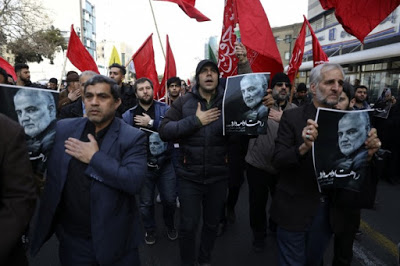The U.S. strategy of ‘creative chaos’ strikes the Middle East again
 |
| Alberto Negri 05/01/2020 |
Washington’s objective is to destroy the Muslim states capable of opposing Israel, the United States’ watchdog in the region, and Saudi Arabia, the biggest client of US weaponry.
The US started the new year with another disconcerting chapter in Washington’s project of permanent destabilization of the Middle East—quite the opposite of the ostensible withdrawal of the United States from the region. The aim was to strike at the heart of the Iranian regime and land a blow against the Shiite security apparatus in Iraq.
Trump ordered the assassination of Iranian General Qassem Soleimani and his Iraqi right-hand man, Abu Mahdi Al-Muhandis. This incoming operation had been hinted at in an article published just 24 hours earlier by the former US intelligence officer Michael Pregent, without anyone taking notice.
We are in the midst of the infamous “creative chaos”—as always, with unpredictable consequences— that the United States has been pursuing for around 20 years, with criminal persistence, right in our backyard.
It was a decision that fit perfectly as part of the American strategy of upsetting the precarious equilibrium of the Middle East. This began with the invasion of Iraq in 2003, continued with the 2011 strikes in Libya against Gaddafi, together with France and the United Kingdom, and went on with the war by proxy in Syria against Assad, a conflict which saw the Gulf monarchies and Turkey, together with the jihadists, committed to fighting against Iranian, and then Russian, influence. All this with the seal of approval of the United States.
Washington’s objective was, and remains, to destroy the Arab and Muslim states that would be capable, in some way or another, to oppose Israel, the United States’ watchdog in the region, and Saudi Arabia, the biggest client of US weaponry, which has been tethered to Washington since 1945 with an iron-clad pact signed between then-sovereign Ibn Saud and President Roosevelt. This longstanding conflict between Shiites and Sunnis, into which the US had already infiltrated itself with Saddam Hussein’s attack on revolutionary Iran in 1980, and which has played out anew in Syria and Yemen, has at its core the aim of eliminating the regime of the Islamic Republic.
The objective of permanent destabilization has been implemented in Iraq, which was plunged into chaos for 17 years, and partly also in Syria, constantly in the sights of Israeli missiles. But Tehran’s influence has survived to this day, in Iraq, in Damascus and especially in Lebanon, where Hezbollah—allies of Tehran—are equipped with a missile arsenal that managed to stop Israel in 2006. The American attack against Soleimani falls within this overall logic: it’s no coincidence that the Iranian general, who was in charge of foreign policy—not only military policy—in the region, was returning to Baghdad from Beirut at the time of the attack. He was the architect of Shiite resistance, someone who used to issue warnings directly to American generals like Petraeus.
As predicted by il manifesto’s previous article on Libya, the tides of war have materialized in Iraq just as expected. But there’s more to the story: just 24 hours before Qassem Soleimani and Al Muhandis were hit by a drone strike at Baghdad airport, the website of the Saudi TV station Al Arabiya published an article by Michael Pregent, a former US agent and consultant to the Iraqi government, in which he explicitly stated: “it is time to go after Soleimani and al-Mohandes – they are enemies of the Iraqi people, the region and the United States.”
Among other things, the former intelligence agent—or not so “former” after all, although he is supposedly just an employee of the Hudson Institute—wrote in his article that Secretary of State Mike Pompeo had made a phone call to Hadi Al-Amiri, a member of the Iraqi Parliament and head of the pro-Iranian Al Badr Shiite brigades, who had just called for American soldiers to be kicked out of Iraq after the attack on the US embassy in Baghdad. In short, Pompeo called him to deliver a warning, because at this point all Iraqi who are allies of Iran are in the US’s crosshairs.
But why did the US choose this moment to hit Soleimani? His presence and his organizational capacity were an insurmountable obstacle in the path of the American plans to make Iraq into a base for anti-Iranian operations. The signs of the escalation in Iraq could already be seen in the weeks before, with the Hezbollah attacks on US personnel and the immediate retaliation by the Americans. Meanwhile, the US is packing its bags to leave Turkey, which has military agreements with Russia and Iran: Incirlik is no longer a safe base for them, whether for storing nukes or for attacking Iran.
Erdogan, who has bought the Russian S-400 anti-missile defense system, is no longer a reliable NATO ally, and had already closed Incirlik after the failed 2016 coup, later reluctantly granting the Americans renewed access to the base for raids against the Caliphate. In consequence, the US has strengthened its presence in Iraq, adding 750 soldiers to the 5,000 already present and transferring a part of its ballistic arsenal and bombs there in case the US should attack the Islamic Republic. Of course, this also included their military drones, which might have been the ones that struck against Soleimani from Iraqi territory.
If this theory is confirmed—as agent Pregent, who seems very well informed, appeared to hint to the BBC—the tension would rise to an explosive level. This is the “beauty” of “creative chaos,” and it leaves us in Italy stuck right in the middle.


